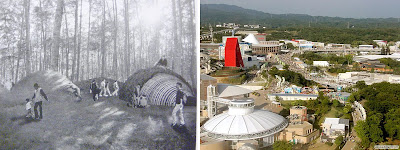
When we think about sustainability, how much should we “preserve” existing environment? In Expo 2005 Aichi, themed “Nature’s Wisdom”, controversial matter occurred between “preservation” and “development” and there was the affair that almost all of their first members of designers and architects resigned from the project in a way. The centre of controversy was an “undeveloped” forest planned as the site. While local community, their government and mass-media stood on “preservation” of the forest, designers and architects kept to propose to “use” the forest. At last, their argument has never met through cycle of discussions and their master plan was severely changed. It is a case-example of design related to politics, economy, society, technology, media, ethics and sustainability.
The initial plan was “in” the forest. “regarding the forest itself as “living exhibition resource” without trucking in great numbers and massive volumes of exhibits from outside the forest”. “And technology, far from being a concept opposed to nature, should have been repositioned as a continuation of nature’s elegance.” Visitors wearing wearable computer would interact with the elements of the forest and acquire information about them, for example “experience the forest with the eyes of a bird or an insect” or on the level of micro-organisms of genes by the latest technology. With Head Mount Display, they can enjoy a virtual opera in the forest. There would be not any big constructions but the forest as living digital archive by minimum installation of devises.
However, to mass, “undeveloped forest” was holy place anyway and untouchable area without any logical reasons. Actually, a nest of rare birds was discovered in the forest and it was crucial to change the master plan. The new plan, the final plan, was basically a conventional type of Exposition. Because of “preservation”, a park “outside” the forest was developed and a number of “pavilions, gigantic-scale image projection, a mega-scale Ferris wheel” were built for presentations of the latest eco-technologies. This Exposition was success as public works and relatively eco-friendly. However, which plan would work better as the Exposition for pointing out future in the concept of “coexistence” of nature, technology and human? "There are not problems that can be easily solved here."
This example is questioning what “preservation” should be and where the “resource / material” should come from. Moreover, it will be some hint for discussions in the lecture of “The Arts of Survival” about Portable Light, which brings different lifestyle into another culture. When we want to introduce something new properly, it should not be “stuck on” but be “melted into” existing environment. If we really want to preserve something precious, we should go inside of its “forest” and analyse what there are, not just fence it off from outside. We need “interaction” rather than “preservation” for sustainability.
Hara, Kenya. Designing Design. p.330-355. (Baden: Lar Muller Publishers, 2007)
“A record of Kengo Kuma’s lecture in Academyhills” http://www.academyhills.com/gijiroku/kumagai/25.html (accessed on 10 Mar. 2007)
Image: Image:
GA. Kuma Kengo 2. p.6 (Tokyo: ADA EDITA, 2004)
"expo 2005 photo esseys" <http://www.antonraubenweiss.com/expo/photos8.html> (accessed on 10 Mar. 2007)
No comments:
Post a Comment
Note: only a member of this blog may post a comment.